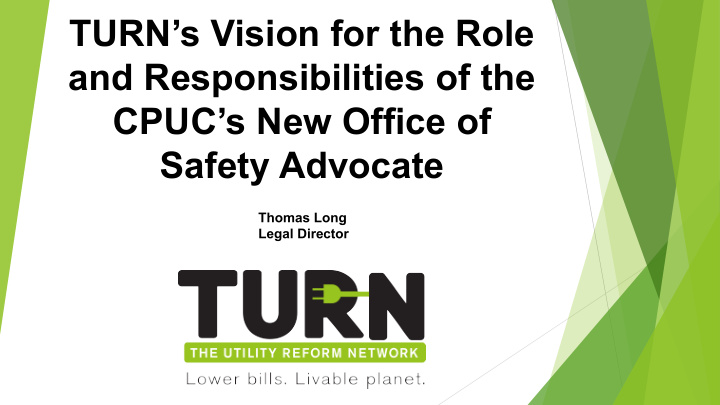



TURN’s Vision for the Role and Responsibilities of the CPUC’s New Office of Safety Advocate Thomas Long Legal Director
Legislation (SB 62) Broad mandate in PU § 309.8(a): “to advocate for the continuous, cost- effective improvement of the safety management and safety performance of public utilities” Key terms: “Advocate” – i.e. , not advisory, but rather a party to CPUC proceedings “Cost-effective” – consistent with PU §§ 451, 963(b)(3) 2
What’s the Problem To Be Solved? Post San Bruno, despite increased focus on safety, utilities are still experiencing significant safety breakdowns Aliso Canyon – 2015-16 Butte Wildfire – 2015 Carmel explosion – 2014 3
What’s the Problem to Be Solved? Disasters like these show that uncritically throwing large amounts of ratepayer money at the utilities’ systems is not the right approach Need better enforcement – a key role for a better-resourced SED Need more thought and care about how ratepayer money is spent – a role for OSA 4
What’s the Problem to Be Solved? The utilities need to do a better job of prioritizing and optimizing their risk mitigation efforts. Utilities need to select the portfolio of programs that will reduce risk to a tolerable level in a cost- effective manner Recognize utilities’ incentives that are contrary to optimal safety spending Rate case requests – incentive to boost rate base and pad expenses Rate case implementation – incentive to spend money without adequate focus on achieving risk reduction results 5
How Can the OSA Help to Address the Problem? Key OSA role: Probe and evaluate utility risk model work and resulting GRC requests A new undertaking: In Safety Model Assessment Proceeding (S-MAP), quantitative models being developed to prioritize and optimize the utilities’ risk mitigation efforts Will shed light and impose rigor on current highly opaque and seemingly arbitrary utility processes of selecting proposed safety mitigation work If this work is done right, it should provide the Commission with exactly the information it needs to promote cost-effective improvement of utility safety performance 6 Will l id f d ti f h ldi tiliti
How Can the OSA Help to Address the Problem? Scrutinizing utility implementation of risk models will be a huge new undertaking More transparency means more responsibility to review inputs and outputs Large number of risks and programs being modeled and complexity of models require a major commitment of resources Too big a job for intervenors alone -- 7 Commission funded OSA needs to take
How Can the OSA Help to Address the Problem? Output of OSA work Based on discovery and analysis of utilities’ efforts, present testimony in GRCs that : Analyzes utility implementation of Commission’s requirements for safety models Analyzes quality of utility inputs and outputs to the models Recommends needed changes to utility proposals in order to optimize 8 portfolio of risk mitigations
How Can the OSA Help to Address the Problem? PU §309.8(b)(3): “Informing the official record on safety-related risks in applicable commission proceedings and assisting the commission in its efforts to hold public utilities accountable for their safe operation.” PU §309.8(b)(1): “Advocating, as a party to commission proceedings and on behalf of the interests of public utility customers, for effective public utility safety management and infrastructure improvements and for the transparency of safety information …” 9
Other Potential Opportunities for OSA Act as an advocate for optimized, cost- effective safety improvements across a variety of proceedings Revisions to safety-related General Orders – e.g., Fire Safety Rulemaking Non-GRC utility applications for safety- related projects and programs, e.g., North- South Pipeline, PSEP 10
Potential Concerns Regarding OSA Will OSA’s analysis be independent of the utilities? OSA must not (even informally) rely on utilities for training and framing of the issues Devote sufficient budget for outside independent training by non-utility experts, including experts in quantitative risk modeling If OSA is a rubber stamp for the utilities, it 11
Potential Concerns Regarding OSA Will OSA exclude cost-effectiveness and optimization from its analysis ? It’s good to have an advocate focused on safety, but . . . A safety advocate that ignores costs and ratepayer impacts is of little help in the real world of limited resources The challenge is to prioritize the use of ratepayer funding considering all of the potential risk mitigation options to obtain optimal safety improvements 12
OSA’s Relationship to Other Intervenors OSA focused on safety-related issues TURN, ORA and other intervenors address safety and many other issues, e.g., climate change issues, energy efficiency, rate design and cost allocation, grid reliability, low-income programs and policies, etc. 13
OSA’s Relationship to SED SED: Enforcement cases and audits - Needs more staffing! Advisory, like Energy Division OSA Treated like a party Testimony subject to discovery and cross- examination, like ORA 14
Thank You!
Recommend
More recommend